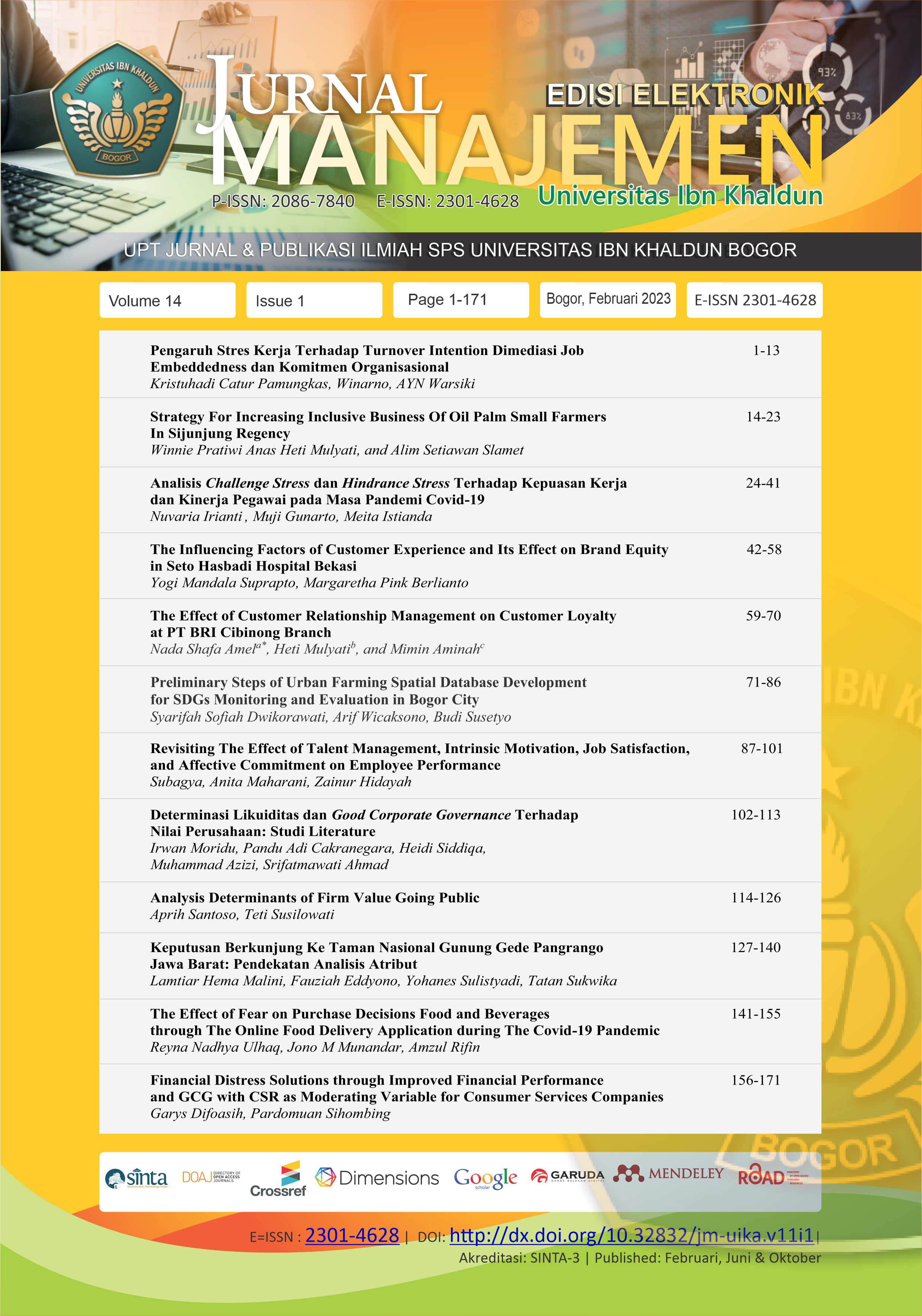Preliminary Steps of Urban Farming Spatial Database Development for SDGs Monitoring and Evaluation in Bogor City
DOI:
https://doi.org/10.32832/jm-uika.v14i1.9110Keywords:
Sustainable Development Goals, Participatory mapping, Urban farming, Focus Group DiscusssonAbstract
The mandate of Presidential Regulation 111/2022 states that the Sustainable Development Goals (SDGs) need to be synchronized with the five-year National Development Plan (RPJMN) at the central government level, and the five-year Regional Development Plan (RPJMD) at the provincial and city/district levels. Further synchronization at the national level will eventually be completed in the National Action Plan (RAN), while at the provincial/city/district level it will produce a Regional Action Plan (RAD). This study aims to prepare the first steps for the development of urban agriculture spatial databases to support the monitoring and evaluation of SDGs and the formulation of RAD in Bogor City. The method used is a descriptive method through a Focus Group Discussion (FGD) with a synchronization analysis between the SDGs and the five-year development plan (RPJMD) of Bogor City 2019-2024. The FGD activity was also attended by 114 representatives of women's farmer groups (KWT). The results of the analysis show that the development of a spatial database of urban agriculture to support the subsequent monitoring and evaluation of SDGs in Bogor City was carried out through an analysis of the role of KWT locations in poverty reduction within a certain radius in each KWT plantation location. This can be an indication that urban farming spatial databases can be used to evaluate SDGs 1 (No Poverty) and 2 (No Hunger).
References
Golay, C. No One Will Be Left Behind: The Role of United Nations Human Rights Mechanisms in Monitoring the Sustainable Development Goals that Seek to Realize Economic, Social and Cultural Rights. Academy Briefing No. 11. Geneva Academy, January 2018.
Fraisl, Dilek, See, Linda. (2020). WeObserve D4.6 / Monitoring of SDGs by COs: Recommendations and priorities, IIASA, Laxenburg, Austria.
Wahyuningsih (2017). Millenium Develompent Goals (MDGS) dan Sustainable Development Goals (SDGS) Dalam Kesejahteraan Sosial. Bisma Jurnal Bisnis dan Manajemen, Vol. 11, No. 3 September 2017, Hal. 390 – 399.
WHO. (2017). Regional Action Agenda on Achieving the Sustainable Development Goals in the Western Pacific. WHO Report.
Jennifer Blesh, Lesli Hoey, Andrew D. Jones, Harriet Friedmann, Ivette Perfecto. (2019). Development pathways toward "zero hunger”. World Development, Volume 118, June 2019, Pages 1-14. https://doi.org/10.1016/j.worlddev.2019.02.004.
Pratama, N.B., E.P. Purnomo2 dan Agustiyara. (2020). Sustainable Development Goals (SDGs) dan Pengentasan Kemiskinan Di Daerah Istimewa Yogyakarta. SOSIOHUMANIORA: Jurnal Ilmiah Ilmu Sosial dan Humaniora, http://jurnal.ustjogja.ac.id/index.php/sosio, Volume 6 (2), Agustus 2020 | LP3M Universitas Sarjanawiyata Tamansiswa Yogyakarta.
Akbar, A., Flacke, J., Martinez, J., Aguilar, R., & van Maarseveen, M. (2020). Knowing My Village from the Sky: A Collaborative Spatial Learning Framework to Integrate Spatial Knowledge of Stakeholders in Achieving Sustainable Development Goals. ISPRS International Journal of Geo-Information, 9(9), 515. MDPI AG. Retrieved from http://dx.doi.org/10.3390/ijgi9090515.
Kelly-Fair, M., Gopal, S., Koch, M., Pancasakti Kusumaningrum, H., Helmi, M., Khairunnisa, D., & Kaufman, L. (2022). Analysis of Land Use and Land Cover Changes through the Lens of SDGs in Semarang, Indonesia. Sustainability, 14(13), 7592. MDPI AG. Retrieved from http://dx.doi.org/10.3390/su14137592.
Leire Iriarte1 & Laura Musikanski (2019). Bridging the Gap between the Sustainable Development Goals and Happiness Metrics. International Journal of Community Well-Being, https://doi.org/10.1007/s42413-018-0012-2.
Setianingtias, R., M. Baiquni, A. Kurniawan. (2019). Pemodelan Indikator Tujuan Pembangunan Berkelanjutan di Indonesia. Jurnal Ekonomi dan Pembangunan Vol 27, No. 2, 2019.
UN Environment (2019) Measuring Progress: Towards Achieving the Environmental Dimension of the SDGs. Available at: https://wedocs.unep.org/handle/20.500.11822/27627.
Pietro Gennari and Dorian Kalamvrezos Navarro. (2019). Validation of methods and data for SDG indicators. Statistical Journal of the IAOS 35 (2019) 735–741. DOI 10.3233/SJI-190519. IOS Press.
Kemen PPN RI/Bappenas. 2017. Ringkasan Metadata Indikator Tujuan Pembangunan Berkelanjutan (TPB)/Sustainable Development Goals (SDGs) Indonesia.
Kemen PPN RI/Bappenas. 2020. Pedoman Teknis Penyusunan Rencana Aksi Tujuan Pembangunan Berkelanjutan (TPB)/Sustainable Development Goals (SDGs) Indonesia.
Jalaali, B. (2021). Implementasi Visi Sustainable Development Goals(Sdgs) pada Program Berbasis Masyarakat di Era Pandemi. KACANEGARA Jurnal Pengabdian pada Masyarakat. DOI: 10.28989/kacanegara.v4i1.711. http://ejournals.stta.ac.id/index.php/KACANEGARA.
Ignacio Marcovecchio, Mamello Thinyane, Elsa Estevez. (2019). Digital Government as Implementation Means for Sustainable Development Goals. International Journal of Public Administration in the Digital Age, Volume 6, Is13sue 3, July-Sept 2019.
Nechita, E., Manea, C. L., Irimescu, A. M., & Nichita, E. M. (2020). The content analysis of reporting on sustainable development goals. Audit. Finance, 4, 704-728.
Osgood-Zimmerman, A., Millear, A., Stubbs, R. et al. Mapping child growth failure in Africa between 2000 and 2015. Nature 555, 41–47 (2018). https://doi.org/10.1038/nature25760.
Mudau, N., Mwaniki, D., Tsoeleng, L., Mashalane, M., Beguy, D., & Ndugwa, R. (2020). Assessment of SDG Indicator 11.3.1 and Urban Growth Trends of Major and Small Cities in South Africa. Sustainability, 12(17), 7063. MDPI AG. Retrieved from http://dx.doi.org/10.3390/su12177063.
Downloads
Published
How to Cite
Issue
Section
License
Authors who publish with this journal agree to the following terms:
- Authors retain copyright and grant the journal right of first publication with the work simultaneously licensed under a Creative Commons Attribution-NonCommercial-ShareAlike 4.0 International License that allows others to share the work with an acknowledgement of the work's authorship and initial publication in this journal.
- Authors can enter into separate, additional contractual arrangements for the non-exclusive distribution of the journal's published version of the work (e.g., post it to an institutional repository or publish it in a book), with an acknowledgement of its initial publication in this journal.
- Authors are permitted and encouraged to post their work online (e.g., in institutional repositories or on their website) prior to and during the submission process, as it can lead to productive exchanges, as well as earlier and greater citation of published work (See The Effect of Open Access).











